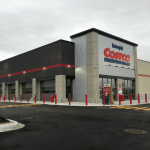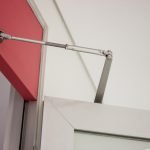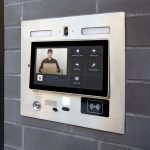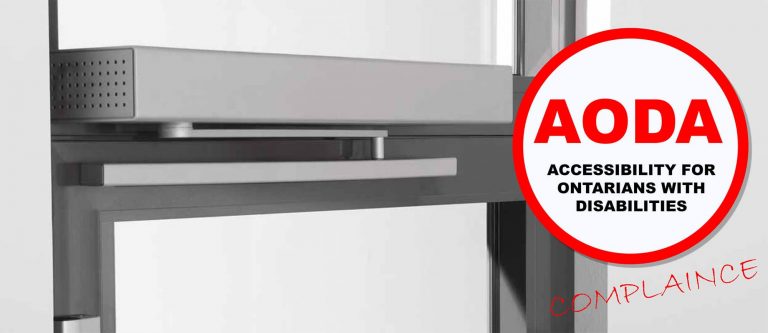Doors openers should – and can – accommodate people of all ages and abilities
Automatic door operators are often used to make door openings accessible and meet the guidelines of the Accessibility for Ontarians with Disabilities Act (AODA), but they also provide added convenience for a wider range of users. Building owners or facility managers may sometimes overlook the benefits of automatic operators when adapting their facilities to comply with AODA guidelines.
Convenience can go hand in hand with AODA compliance. For example, mechanical door closers that are adjusted to higher closing powers for certain doors are often not AODA compliant and can be difficult to open by anyone. On the other hand, it may be possible under certain conditions to comply with AODA by adjusting the mechanical door closer force to Size 1. However, this may not provide enough power to close the door completely due to weather conditions and building pressures. In most cases, automatic door operators are the best accessibility option. Typically, it may only be necessary to install one automatic door iff the front entrance has a bank of doors.
The AODA guidelines should not only be used for accessibility designs but also to serve all visitors of a facility. In addition to meeting the needs of the nearly 2 million Ontarians with disabilities, an accessible building is more convenient for the elderly, children, people carrying heavy loads, or parents pushing strollers. It is a business advantage to create a universal environment that accommodates all groups of people.
Although the latest guidelines aren’t official yet, they differ from the previous version primarily in format or organization. It makes sense to become familiar with the changes and work to implement them before they become mandatory. Being proactive can help a building owner or facilities manager avoid issues on current and planned projects and ensure they remain compliant.
Many Types of Automatic Operators Available
Manufacturers provide a wide variety of automatic door operators to meet the many different combinations of door openings, traffic patterns and conditions. Some of the types available include:
- Electro-hydraulic low-energy automatic operators.
- Concealed pneumatic low-energy automatic operators.
- Pneumatic low-energy automatic operators.
- Electro-mechanical low-energy swing-door automatic operators.
- Electro-mechanical low-energy with reduced manual opening force swing-door automatic operators.
- Electro-mechanical low-energy automatic operator for light- to medium-traffic applications.
- Electro-mechanical high-energy automatic operator for high-traffic applications.
- Such a variety of choices may be confusing to decide the right option for your facility. The following brief review of the main characteristics of each type may help when selecting an automatic operator.
Electro-hydraulic low-energy automatic operators are designed primarily for manual opening applications where there is an occasional need for automating the door to meet AODA requirements. They combine a conventional heavy-duty door closer with a low-energy automatic operator. One manufacturer incorporates a highly reliable 10-million cycle, cast iron door closer, and a digital control suite with onboard diagnostics that makes installation a simple plug-and-play process. Typical installations might include a door in a school building that operates manually most of the time, but can be activated in automatic-operator mode with a touch plate close to the door, either on a wall or bollard post. Some facilities use wireless remote devices issued only to those who need them to avoid abuse or misuse of the operators.
Electro-hydraulic low-energy automatic operators
Concealed pneumatic low-energy automatic operators are ideal for applications where aesthetics are important while still meeting AODA guidelines for manual openings that require occasional automatic opening. They are built around a heavy-duty door closer for manual operation, combined with a pneumatic low-energy operator to power the door when required. Power for the operator can come from the building’s in-house air supply, if available, or from a small remote compressor available from the door operator manufacturer. In a library, pneumatic operators provide accessibility without visibility and their quiet pneumatic operation is an added advantage. The compressor can be used to power more than one door, providing a significant cost advantage where multiple powered doors are required.
Pneumatic low-energy automatic operators are also available for surface-mount applications. Pneumatic operators are a great solution for use in hazardous areas where electrically operated devices are not permitted. They are ideal for multiple doors because the cost per door leaf decreases significantly as the number of doors increases. Additionally, in locations such as libraries, churches or hospitals that require quiet operation, they can be combined with pneumatic exit devices for safety and silence.
Electro-mechanical low-energy automatic operators
Electro-mechanical low-energy swing-door automatic operators are designed to open automatically when activated and also allow manual operation. Unlike the previous operators, they are not built around a door closer; rather, they are gear-driven for applications where automatic operation is the primary mode. They typically are activated by an actuator mounted on a wall or bollard post. There is one system that provides automatic power assistance for those who need it once the door is pushed. Other available features include power boost-assisted closing to ensure secure latching when dealing with winds or pressure changes. There is also an auto-reverse on the open and close cycle, which reverses operation if the door comes into contact with a person or object. Typical applications include cross-corridor doors or other frequently used openings in hospitals or student housing.
Electro-mechanical low-energy automatic operators for light to medium-traffic applications are designed to provide cost-effective and reliable access for people with disabilities and the elderly. They can be retrofitted to existing manual doors and also include push-and-go operation to achieve automatic operation without the added expense of optional activation accessories. These units are ideal for interior doors such as bathrooms and utility closets.
Electro-mechanical high-energy automatic operators for high-traffic applications are designed to manage heavy traffic flow in areas such as retail stores or airports. They provide a flexible solution with control over opening speed, backcheck speed and position, latch position and hold-open duration. Unlike the low-energy operators, these high-energy products require added safety devices, such as safety mats or other sensors to control the flow of users through the door and guard rails to keep non-users in the area away from the door’s swing path. The sweep of a high-energy door operator typically is about 1.5 seconds, compared to the 3- to 5-second sweep of a low-energy operator.
While the final decision of choosing an automatic door operator will depend on the needs of the specific application, following AODA guidelines will ensure that people with disabilities will have the accessibility they need and will also provide convenience to others.


























